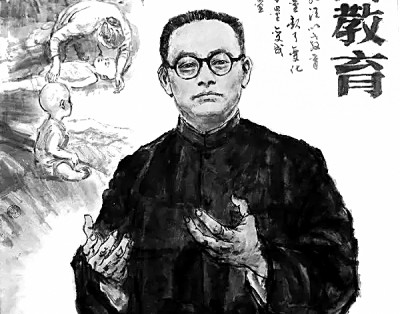When Mr. Tao Xingzhi held the position of the school principal, he saw a boy throwing a brick at another boy. Not only was this bullying behavior, but it was also very dangerous. Principal Tao stopped the boy and told him to come to the Principal’s office at three o’clock that afternoon.
By three o’clock, the boy was waiting by the door of the Principal’s office. He felt a mix of complex emotions: anger, guilt, fear of being scolded, shame, and worry about his parents’ reactions.
However, Principal Tao wanted to take a different approach to teach the boy how to do better. He went to a small shop to buy a package of candies as part of his plan.
When Principal Tao returned, he smiled at the boy and took out the candy. He said to him: “This candy is for you because you are very trustworthy and arrived early.” The boy was completely stunned at being given candy.
Then the Principal took out another candy and said, “This one is also for you. In exchange for this candy, You showed me respect by ceasing to do something when I tell you to stop.” The boy was even more surprised, but he agreed.
Principal Tao continued: “For all I know, you threw a brick at your classmate because he was bullying a girl. This would demonstrate that you are kind and have a sense of justice. So I will reward you with another candy.”
The boy was deeply moved by the fact that Principal Tao respected and trusted him. It encouraged him to think more objectively about the situation, so he said: “Principal, I was wrong. No matter how badly my classmates behave, I can’t throw bricks at them.”
Principal Tao smiled with satisfaction and took out another candy: “It’s rare for someone to admit to their mistakes, so I have to reward you with another candy. I am now out of candy, so our conversation is over.”
Mr. Tao Xingzhi is good at discovering how to motivate children by appealing to their better qualities. For example, he used candies to banish a child’s negative emotions so that he could think more clearly about what he had done wrong.
These four ordinary candies were used by Tao Xingzhi to encourage virtue:
The first candy: trust and support.
The second candy: respect and understanding.
The third candy: appreciation and encouragement.
The fourth candy: tolerance and consideration.
Reference:http://www.bestgushi.com/l/z/25667.html
陶行知
「四顆糖」的故事
教育家陶行知先生當校長的時候,有一天看到一個男生用磚頭扔另一個男生,十分危險。陶校長便將其制止,並叫他下午三點到校長辦公室。
沒到三點,男孩就到校長室門口等候,內心比較複雜:沒發洩完的憤怒、錯誤行為的自責、面對校長責問的恐懼、同學們即將看笑話的羞愧、還有可能找家長的擔憂……,他低著頭等著挨訓。
然而,陶校長早洞察到孩子的內心世界,他去小賣鋪買了一包糖果,一場偉大的教育即將發生。
陶校長準時回到辦公室,發現男孩已經等在那裡。他笑著掏出一顆糖對男孩說:“這顆糖是給你的,因為你很守信,沒遲到還提前了。” 眼前的這顆糖令男孩完全出乎意料,他驚呆了。
接著校長又掏出一顆糖,說:“這也是給你的,我讓你住手,你就立即住手了,說明你很尊重校長,尊重別人是最重要的品質啊。” 男孩真的沒想到不但沒有被責罵,還被表肯定了。內心再次驚訝!
陶校長又說道:“據我瞭解,你拿磚頭扔同學是因為他欺負女生,這說明你善良,有正義感,我再獎勵你一顆。”
男孩被陶校長的尊重、信任、肯定和鼓勵深深感動,良知慢慢被點亮,男孩說:“校長,我錯了,同學再不對,我也不能採取這種方式。”
陶校長滿意地笑了,又掏出一顆糖:“你知錯認錯,實在難得,不得不再獎勵你一顆,我的糖發完了,我們的談話也結束了,回去吧!” 男孩手握四顆糖,眼神裡充滿著一種前所未有的光。
陶行知先生善於發現孩子的閃光點並巧妙激勵,用四顆糖化解了孩子心中的憤怒、自責、恐懼和羞愧,如同一道光照亮了孩子。
這普普通通的四顆糖,在陶行知的手中似乎有了生命:
第一顆糖:尊重和理解。
第二顆糖:信任和支援。
第三顆糖:賞識和鼓勵。
第四顆糖:寬容和體貼。













